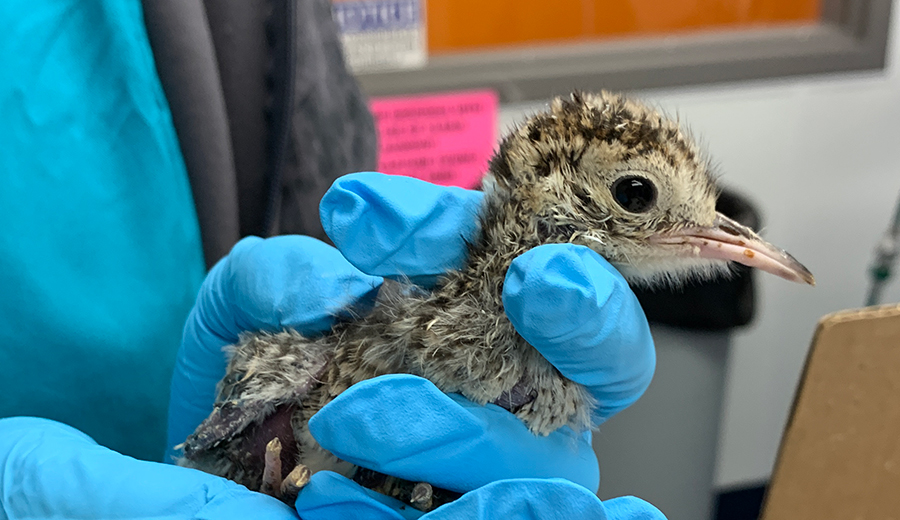Enjoy the Most-Read Columns from 2017
What topics did pet owners find most fascinating last year? We checked our website analytics, and discovered that fungal disease, behavioral issues, and cutting-edge treatments offered only at our college topped the list. Here’s a recap of our most-read columns.
Blasted Blasto
![[blastomycosis dog]](https://vetmed.illinois.edu/wp-content/uploads/2021/04/pc-blasto-dog-300x180.jpg) Blastomyces dermatitidis—the agent responsible for the systemic infection blastomycosis—is common in the Midwest, according to Dr. Ian Sprandel, a veterinary pathologist at the University of Illinois.
Blastomyces dermatitidis—the agent responsible for the systemic infection blastomycosis—is common in the Midwest, according to Dr. Ian Sprandel, a veterinary pathologist at the University of Illinois.
This fungus lives in the soil and most frequently infects dogs, although cases have also been recorded in horses and cats, both domestic and feral.
Because the fungal spores travel throughout the body, blastomycosis has a wide variety of clinical signs, including loss of appetite, weight loss, trouble breathing, cough, eye disease, lameness, and sores on the skin. Frustratingly, clinical signs are often non-specific and vary based on organ system involvement. And sometimes it takes weeks or months for signs to develop.”
However, if your pup does contract this disease, a speedy visit to your veterinarian is important. Very few dogs with blastomycosis can recover on their own; most require veterinary care and aggressive treatment with antifungal medications.
Read more: Midwest Dogs at Risk of Fungal Infection Blastomycosis
Don’t Blame Dominance
![[pet column dominance - wolves]](https://vetmed.illinois.edu/wp-content/uploads/2021/04/pc-dominance-ballantyne-300x180.jpg) Think your dog’s aggression or other misbehavior arises from dominance issues? Think again. That’s simply not true, according to Dr. Kelly Ballantyne, a board-certified veterinary behaviorist who sees pets and owners at Veterinary Behavior at Illinois, a Chicago-based service of the University of Illinois.
Think your dog’s aggression or other misbehavior arises from dominance issues? Think again. That’s simply not true, according to Dr. Kelly Ballantyne, a board-certified veterinary behaviorist who sees pets and owners at Veterinary Behavior at Illinois, a Chicago-based service of the University of Illinois.
What about dogs being the alpha of the pack, like their ancient relatives?
“Domestic dogs are not wolves,” Dr. Ballantyne emphasizes. “They do not have the same kinds of interactions with their environment or with each other.”
So why is the idea of dominance such a popular explanation for canine behavior?
Because it’s easy. It’s easier to dismiss a dog’s actions as a display of dominance rather than spending the extra time and energy to uncover the root of the problem. Many times the problem turns out to be anxiety-based.
Read more: Dominance Is Not the Answer
Hope for Cats with Cancer
![[Dr. Alycen Lundberg works on mouth cancer in cats]](https://vetmed.illinois.edu/wp-content/uploads/2021/04/pc-oralcancer-lundberg-300x180.jpg) Currently, cats diagnosed with feline oral squamous cell carcinoma, the most common mouth cancer in cats, have very limited treatment options and life expectancy. In 2017, researchers at the University of Illinois received a grant to examine a promising new treatment.
Currently, cats diagnosed with feline oral squamous cell carcinoma, the most common mouth cancer in cats, have very limited treatment options and life expectancy. In 2017, researchers at the University of Illinois received a grant to examine a promising new treatment.
“Cats diagnosed with oral squamous cell carcinoma typically present with large tumors or advanced disease and live about 2 to 3 months following treatment with radiation and chemotherapy,” says Dr. Alycen Lundberg, a veterinarian who sees patients through the Cancer Care Clinic at the Veterinary Teaching Hospital in Urbana.
That is why it is important to find a new and effective treatment for this type of cancer.
IB-DNQ is a new anti-cancer drug administered intravenously. It has already demonstrated positive results in pilot testing with cats. According to Dr. Lundberg, when the new drug was used in combination with radiation, there was close to a 45 percent decrease in tumor size.
Read more: New Treatment for Mouth Cancer in Cats
Relief for Flat-Faced Pets
![[Sonny, a French bulldog, in the University of Illinois veterinary hospital]](https://vetmed.illinois.edu/wp-content/uploads/2021/04/pc-late-feature-300x180.jpg) In June 2017, a new surgical procedure was performed for the first time in the United States at the University of Illinois Veterinary Teaching Hospital. The surgery provides relief for pets afflicted with brachycephalic syndrome, the condition that causes snoring, difficulty breathing, susceptibility to overheating, trouble with anesthesia, and more in dogs and cats bred to have very short noses, such as pugs and persians.
In June 2017, a new surgical procedure was performed for the first time in the United States at the University of Illinois Veterinary Teaching Hospital. The surgery provides relief for pets afflicted with brachycephalic syndrome, the condition that causes snoring, difficulty breathing, susceptibility to overheating, trouble with anesthesia, and more in dogs and cats bred to have very short noses, such as pugs and persians.
The procedure was developed by a German veterinarian, Dr. Gerhard Oechtering, and involves removing small amounts of tissue inside the dog’s nasal cavity. The surgery was performed by Drs. Heidi Phillips and Brendan McKiernan on a young French bulldog, and it was a success! By the end of August, the surgeons had performed the procedure on several more patients, with additional patients scheduled for evaluation.
Dr. McKiernan is a specialist in small animal internal medicine and an internationally known expert in respiratory diseases of companion animals. Dr. Phillips is a board-certified small animal surgeon with special interests in soft tissue and microsurgery.
Read more: New Hope for Pets with Brachycephalic Syndrome
Why Is Your Dog Barking?
![[barking dog looking out window]](https://vetmed.illinois.edu/wp-content/uploads/2021/04/pc-barking-ballantyne-300x180.jpg) If you’re using a quick fix to stifle your dog’s excessive barking, you’re probably barking up the wrong tree. Veterinary behaviorist Dr. Kelly Ballantyne weighed in on this topic, advising owners to find out why their pooch is barking in the first place to find solutions that address the underlying issues.
If you’re using a quick fix to stifle your dog’s excessive barking, you’re probably barking up the wrong tree. Veterinary behaviorist Dr. Kelly Ballantyne weighed in on this topic, advising owners to find out why their pooch is barking in the first place to find solutions that address the underlying issues.
One thing that doesn’t work: Yelling to get the dog to stop barking.
“At best, dogs may perceive that you are barking with them, but a worse outcome would be that you scare them,” she says.
Even if the yelling temporarily interrupts the behavior, the dog hasn’t learned how to change the behavior or what you want him to do instead of bark.
Read more: Decoding Your Dog’s Excessive Barking




